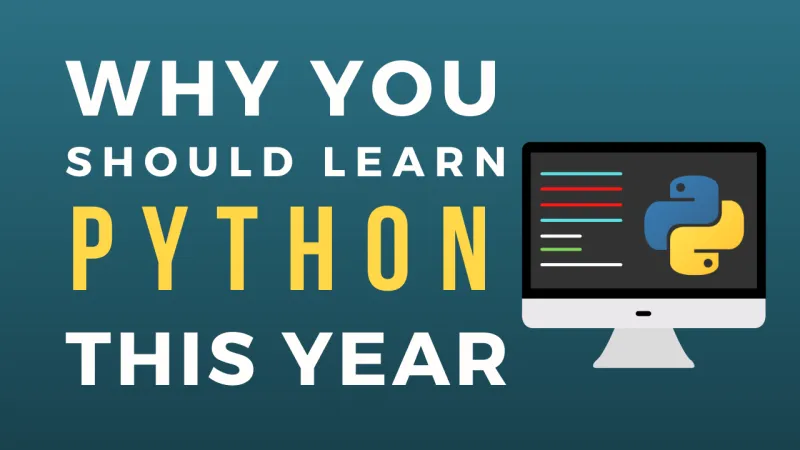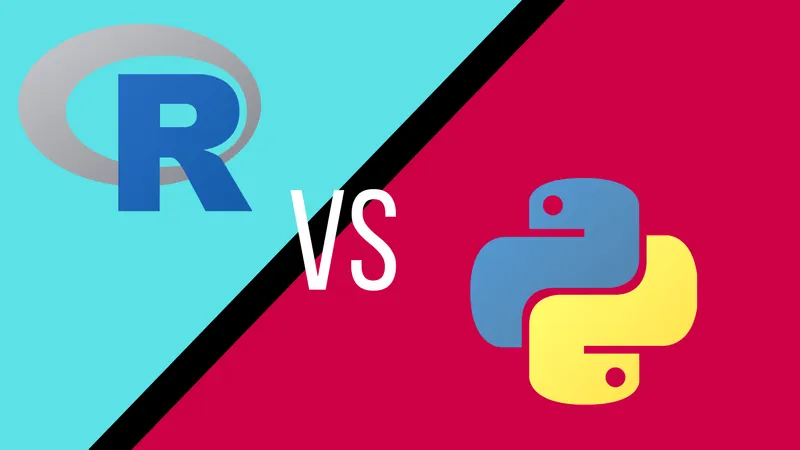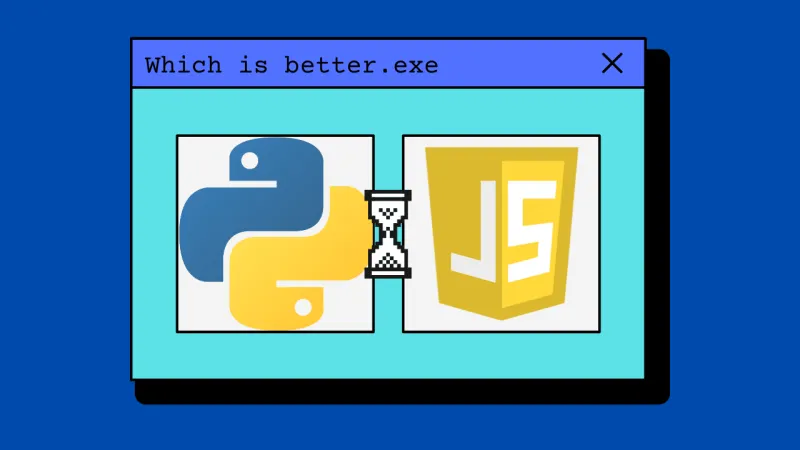Simple to learn, endlessly versatile, and perennially in demand by employers paying higher and higher salaries every year — it feels like there’s a million reasons to learn Python.
I mean, what’s not to love about being a Python programmer?
With a good set of Python skills you can work in data science, machine learning, AI, finance, automation and scripting, web development, game and app development, security, network programming, and so many more attractive and well-paid career fields.
With that in mind, we’ve put together our top reasons why you should learn Python this year. But first, here’s a quick intro to Python and how it became so popular.
What is Python? 🔗
Python was first developed by Dutch programmer Guido van Rossum over the Christmas period in 1989. Seeing he had some spare time over the festive season, he developed Python as a scripting language based on the ABC language. Until recently hailed as the Python “benevolent dictator for life”, Van Rossum is all but retired now, having since worked for companies like Google, Dropbox, and more recently Microsoft.
Python is a high-level programming language designed to read as easily as possible. Its syntax follows plain English — a breath of fresh air compared to less intuitive languages like Java or C++ — and it’s an object-oriented language that can also support functional programming, as well as empirical and structured paradigms.
We also have a course on functional programming
Python is dynamically and strongly typed, helping detect any errors you’ve made quickly and painlessly. As an interpreted language, Python code can run as soon as you’ve written it — so there’s no delay in getting results, unlike code written in C++ or Java. And, as it’s open-source, a huge range of frameworks and libraries have been developed on top of Python, for machine learning, AI, and many other uses.
Why Learn Python? 🔗
Here are our top 9 reasons why you should learn Python this year:
1. Python is incredibly versatile 🔗
Python was originally popular back in the 90s for scripting and automation — and many Python developers will have read the infamous “Automate The Boring Stuff” book for Python scripting.
Now in the present day, Python serves so many industries that it would be impossible to name them all here. While it’s seeing huge growth in popularity in the data science field, it’s also widely used across marketing, recruitment, web development, AI and machine learning, game development, graphic design, and many more.
Research by ActiveState found some of Python’s biggest use cases included creating business insights with machine learning in the insurance industry, helping in retail banking with data transformation and manipulation, data mining in the finance industry, and predicting disease prognosis in healthcare.
Not only does it serve so many industries, but it’s also incredibly versatile in how it works and adapts. You can seamlessly program in Python on Windows, Mac, or Linux, and you can even perform cross-language operations, for example, to call Java or C++ code.
2. Python is easy to learn and write 🔗
Python is widely considered a very easy language to learn and write. Guido van Rossum focused on making it as simple and lean as possible, getting rid of anything complex, and keeping only what’s necessary.
This efficiency means that the average Python program can be written in fewer lines of code than almost any other language. Therefore, you can write complete scripts and programs faster and be more productive in Python.
As a result, Python is commonly used for rapid prototyping, especially in engineering startups striving to quickly build an MVP.
The readability and efficiency make Python one of the easiest languages to learn, especially as a first programming language for beginners. Python’s ease of use has led it to become a popular language for schools, colleges, and other learning institutions, who use it to teach their students a first programming language. It also features built-in automatic memory management, such as for caching and allocation, so you can focus on your code.
A WP Engine survey found that developers considered Python the world’s second easiest-to-learn programming language — only more difficult to learn than HTML!
3. Enormous community and huge range of libraries and frameworks 🔗
One of the biggest advantages of being such a popular language is the large community that surrounds it. Beyond just the Python community as a whole, sub-communities discussing and advising on areas like machine learning, AI and web development are an invaluable source of information and inspiration — especially when you’re just getting started and learning the ropes.
Python is the fourth most popular language for coders via a survey on StackOverflow, has an enormous community on GitHub, and there are also over 860,000 people in Python User Groups worldwide.
Python’s large community has developed a wide range of frameworks and libraries that augment Python’s already impressive use cases.
Some major libraries and frameworks for different areas include:
| Data Science | NumPy, SciPy, Pandas, SciKit-Learn, Matplotlib, Pytorch |
| Machine Learning | SciKit-Learn, PyBrain, PyML, TensorFlow, XGBoost, Keras, Seaborn, Theano |
| Web development | Django, Pyramid, Flask, CherryPy, Grok, TurboGears, Web2Py |
| Network Programming | Asyncio, Pulsar, Pyzmq, Diesel, Twisted |
| Scraping | Beautiful Soup, LXML, Selenium, Scrapy, Requests |
Most Popular Python Libraries
And this popularity also means it’s frequently updated — many updates have been introduced in just the last few years, bringing general performance increases and more natively built-in functions. Python updates are launched generally every 1-2 months.
4. Wide use in data science and machine learning 🔗
R was long considered the gold standard for data science programming languages, but Python has emerged as a serious contender for R’s crown.
A major reason for Python’s growth is its accessibility: non-math experts prefer Python’s intuitive and readable syntax, providing a much flatter learning curve into data science and analysis.
Dig deeper with our article comparing R vs Python
Python is also considered more scalable and overall easier to maintain than R. Python data science packages like NumPy and Pandas greatly add to your data science capabilities, and Python is also used extensively to collect and conduct research for machine learning and AI, with frameworks such as Google’s TensorFlow also available.
5. High paid and very in demand by employers 🔗
StackOverflow’s 2020 survey named Python the most wanted programming language by developers. More and more devs see the value in Python and are looking to learn to meet the enormous glut in demand for Python programmers wanted by employers worldwide.
Not only is it in demand, but it’s also one of the most loved languages by Python programmers. In the same StackOverflow survey, Python ranked third for most loved, trailing just Rust and Typescript.
All this demand has pushed salaries sky-high, with the median salary for a Python developer currently $120,000 per year in the US. That makes Python one of the highest-paid programming languages around, only narrowly edged out by the highest-paid languages like Go.
6. Widely used in cybersecurity 🔗
Python’s versatility makes it a very desirable language for security professionals. By default and with no third-party add-ons, you can create port scanning, attack simulations, wireless network scanning, load generation, intrusion detecting systems, and much more.
And you can do even more when you factor in third-party libraries and frameworks. These include Faker, Cryptography, Beautiful Soup, Matplotlib, Scipy, Nmap, Yara, and many others, giving you all the tools you need to create cutting-edge defense systems, malware analysis tools, penetration tests, and sending and decoding packet programs.
Python’s skill with automation is priceless for security — 90% of data breaches in the UK in 2019 were down to human error. This proves just how important automating away human errors are to keep your business or project safer, and why simple and intuitive languages are so valuable.
7. As a scripting language, Python is great for automation 🔗
Python’s great data structure support — with many types including lists, dictionaries, sets, and tuples — make it easy to manage data, and automate data creation and storage.
Mainly used for scraping data, tools including Selenium, Beautiful Soup, Requests, and many others make this super simple, and scraping is used for marketing and sales work, e-commerce, SEO, machine learning, and much more.
You can automate almost anything if you’ve got the Python skills, but a few automation projects include reading and writing files, automatically sending emails, interacting with APIs, converting currencies, and converting images (for example from PNG to JPG).
8. Wide uses in finance 🔗
Finance and banking are known for some of the highest salaries around, and Python is hugely popular for finance — and still growing in popularity.
Citibank now offers Python coding lessons to banking analysts and traders so they can make use of Python’s incredible data science toolset, and Python is widely used in risk management, the creation of trading bots, quantitative finance for analyzing big financial data, and more.
Scipy, NumPy, Matplotlib, and a range of other add-ons make it easier than ever to perform and visualize financial calculations and algorithms — so not only can you work with the data, but you can more easily communicate the results to key decision-makers.
Economists use Python for their economic analysis due to its simplicity and flatter learning curve. Stripe, Venmo, Robinhood, cryptocurrency Dash, and many other huge projects have also adopted Python.
9. Many of the world’s largest companies use Python 🔗
If you’re looking for a job with one of the world’s largest companies, your Python skills may be what gets you in the door.
Name a large company, and they’ve probably adopted Python in some capacity. So, if you’re thinking “why learn Python?”, a very good reason is that it lands you a prestigious job with the top tech companies, and even government organizations.
Here’s a list of some of the companies that use Python:
- Netflix
- Amazon
- Quora
- eBay
- Slack
- Dropbox
- Spotify
- Paypal
- Stripe
- Uber
- Lyft
- Shopfy
- Mozilla
- NASA
- The CIA
- The SEC
It’s basically a who’s who of top companies.
Here’s how we recommend you learn Python 🔗
We’re confident that Python will continue to be a major player in computer science, and hope to have answered your questions on why you should learn Python this year.
Python is a fantastic language, and we developed our Learn Python course because we’re so confident it’s the future. Our Python course teaches you the basics of Python, with over 65 lessons that take you from beginner to intermediate. After that, we have a range of more specialized courses in Python, such as our Data Structures and Algorithms course, and our Data Structures and Algorithms 2 course.
All our courses are free to audit, and we’re in the process of developing an entire computer science curriculum to take you from your current level to a CS grad.



